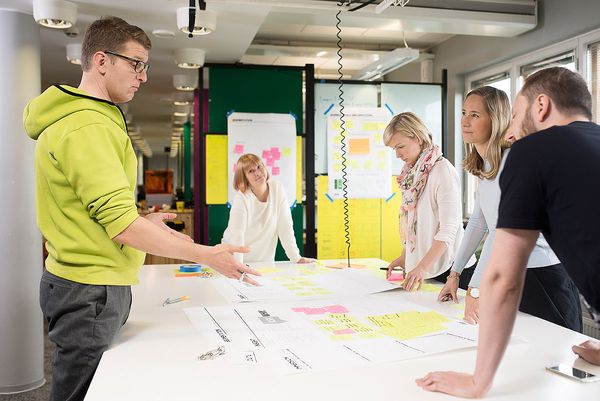How to teach Lean Service Creation – Lessons learned + Slides
After teaching Lean Service Creation at Aalto University for several years I've learned that a good design course should maximise reality, help participating companies to find the benefits of student work, constantly have the students re-package their intermediate results, and to focus on coaching over lecturing. I also share with you my lecture slides from last Fall's course to give you perhaps new ideas and perspectives to teaching lean and service design.
 "...and that is how I teach this at Aalto", Risto explains to his colleagues at Futurice. The colleagues look slightly sceptical :)
"...and that is how I teach this at Aalto", Risto explains to his colleagues at Futurice. The colleagues look slightly sceptical :)
I've taught service design methodology for 4+ years at Aalto University. I started with an ideal situation: a clean slate, a non-mandatory course, and freedom to teach it any way I want. If you have ever taught in a university, you appreciate the opportunity start from scratch and have no formal bureaucracy peeking over your shoulder.
The course is known as Digital Service Design (CS-E5002 in Aalto University coding). It is taught every Monday afternoon (circa 4h of lectures & workshopping per session) in period 1 (i.e. six weeks from September to mid October). In the course I have four teams of four students. I do the teaching and coaching plus I have two mentors helping the students outside the official lecture times.
Long story short: the course has been a huge success. It has won awards as one of the best in Aalto Computer Science (three times, I think), and it was a one of the key arguments in awarding me the teacher of the year in Aalto School of Science, in 2016.
I believe it has become a success because I have learned so much from others: students, visiting lecturers, and fellow teachers. That is why I want to give back and share some of my thoughts and lessons learned behind the course. And also, in the spirit of open source, I share my (almost) unadulterated, unfiltered, unabridged slides I used in teaching the course in Fall 2016.
Lesson learned #1: Maximise reality
Have a real company (or organisation) with a real business goal. Much of design work is not mastering a method, but understanding the surroundings and applying the methods. Without a real company and a real case the students don't bump into the unseen challenges and opportunities that messy reality is full of.
However, having a real case in the course for students to work with means that you have to do a lot of groundwork to get those cases, and then massage them to fit the course schedule and context. Obviously, the course is not 100% business reality because the course’s main goal is to teach the students, and at the end of the day, that overrules the actual business goal. Making this clear helps you, the students, and the client company manage the expectations. Which brings me to the next principle...
Lesson learned #2: Underline the client company's benefit
To get a real company case, the course must be beneficial to the client company. This is not as easy as it sounds. Sometimes companies just “throw the dog a bone” rather than making the most out of the fact that super smart students are putting hundreds hours of their time into solving the company’s problem under professional supervision. Having seen hundreds of real business projects and hundreds of student projects, I know that students projects are enormously undervalued. Students are very, very smart and talented. Especially under good guidance and coaching from the teachers and the client representative.
Once the client company realises how to benefit from the student work it becomes part of the client’s other “processes”. This means that they take the course seriously and they have a true interest in helping the students as much as possible. To make this happen, there must be a dedicated person from the client side that has a personal interest in the course and the students creating something useful.
This bridging between the client company and the students' work will not be automatic. I typically start "selling" the course to companies in the Spring, over three months before the course to help the clients be ready to maximise the great work the students will create.
Lesson learned #3: Constant re-packaging
In my course the students have only six weeks to consume, digest, and analyse a huge amount of information, inspiration, and creativity. To speed up the process the key is to have every team present their findings and thinking as often as possible. And to present it in a packaged format that requires the team to understand where they are and what they know and don’t know. Forcing the teams to produce a coherent message of their current thinking and status is extremely productive in helping the team to see what is important, to build a shared understanding, and to focus on relevant next steps.
The Lean Service Creation canvases work here perfectly. They give good focus to the discussions and they also force all the teams into same format. In addition, in the past years I have asked the teams to produce a short video after each week (according to the theme of the week, such as, value proposition or experimentation), and these videos are then shared with clients and fellow students. This is pretty much the only documentation or reporting I make the students do during the course, and it has worked like a charm.
Lesson learned #4: Coaching over lecturing
A method course should be hands-on. That is obvious. However, I think that before applying a method, one has to understand the theory behind it. That is why I have short(ish) lectures (30-40minutes) with lot of examples and often some pair exercises to help the students understand the theory. More time goes into coaching the teams with their company cases. In other words, going from team to team and helping them to apply what was just lectured to them.
Due to student feedback, I created a special “clinic” outside class, where the course mentors and myself help the students further. I noticed that the students need one or two days to work on their topics (i.e., to digest all the new knowledge) and then they are ready for the next round coaching.
Also, I have now framed the client’s role as a coach of the team rather than a “client who judges your final results”. This breaks down the prejudice that the client has all the right answers and is just waiting for the team to “get it right”. Rather, the client-as-a-coach helps the team to compete the other teams by doing her/his share and removing obstacles and barriers in front of the team (e.g., helps in arranging customer interviews, provides access to data, meets the team on a weekly basis etc).
My slides from fall 2016
I did not have time to make these slides into a more approachable set but I do hope that these help teachers, coaches and educators anywhere to get ideas and re-use things when teaching Lean Service Creation or service design in general. The only changes I made to the original slides was that I took away some photographs of people that I didn’t have time to ask permission. The Powerpoint files have also some notes in them (in Finnish or English) so check them out. I also included my grading review (not the grades, though) from last Fall, so you can see how I evaluate the work for the final grade.
Let me know if these slides are helpful, and whether I should spend some time making them more understandable :)
Here they are:Introduction to Lean Service Creation and the courseCustomer Insights and InterviewingIdeation and Value propositionsBusiness Model and Customer JourneyExperiments and MVPStorytelling and PresentingGrading/evaluation
 Edward and Jouni working on their company case in the DSD course.
Edward and Jouni working on their company case in the DSD course.
- Risto SarvasService Designer, Professor, Company Culture Engineer



